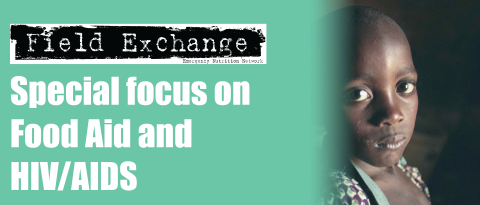WFP Recipients’ Weight Gain at Reach Out Clinic
By Antonia Torreblanca and Eileen Kim
This report outlines the weight progress of clients attending the Reach Out clinic of Mbuya parish clinic in 2002, who were receiving WFP food (see field article p28).
Both Antonia Torreblanca (MD, MPH) and Eileen Kim (MD) worked as physicians at the Reach Out clinic, Kampala, Uganda in November 2003. They are currently working as attending physicians at the Kaiser Permente Medical Centre, California, USA.
In October 2002, the medical records of 100 clients who were registered to receive World Food Programme (WFP) food through the Reach Out Clinic-Mbuya Parish HIV/AIDS Initiative were reviewed. The programme was based in Kampala, Uganda.
The food disbursed was based on a family size of 5, and was intended to comprise 50% of the food needs of the family. It consisted of maize meal (25 kg every 24 days), beans (25 kg every 45 days), corn-soya blend flour with micronutrient fortification (25 kg every 3 months), and cooking oil (4 L every 2 months).

Table 1 outlines the baseline characteristics of clients enrolled in the WFP-Reach Out programme. Of the 100 clients that began receiving food in October 2002, 85 were alive at 1 year. Of those 85 clients, 35 (41%) had HIV, 49 (58%) had HIV and TB, and one person (1%) had TB alone.
| Table 1 Baseline characteristics of clients enrolled in the WFP-Reach Out programme | |||
| A. Characteristics of the 85 clients alive at 12 months | |||
| Characteristics | HIV/TB N=48 |
HIV alone N=36 |
TB alone N=1 |
| Mean age, yr (SD) | 36 (+9.6) | 35 (+8.4) | 45 (N/A) |
| Female, no. (%) | 38 (79%) | 35 (97%) | 0 (0%) |
| Mean wt, kg (SD) | 54 (+9.7) | 59 (+10.9) | 68 (N/A) |
| Started on HAART1 | 11 (23%) | 8 (22%) | N/A |
| B. Characteristics of the 15 clients deceased at 12 months | ||
| Characteristics | HIV/TB N=13 |
HIV alone N=2 |
| Mean age, yr (SD) | 36 (+6.7) | 37 (+2.1) |
| Female, no. (%) | 8 (62%) | 2 (100%) |
| Mean wt, kg (SD) | 57 (+13.2) | 55(+0) |
| Started on HAART1 | 3 (23%) | 0 (0%) |
| Table 2: Weight change according to disease status | ||||
| Disease Status | Wt change, 4 months to start | Wt change, 3 months | Wt change, 6 months | Wt change, 12 months |
| HIV+TB | + 0.40 kg (P=0.40) | +1.01 kg (P=0.044) | +2.49 kg (P<0.001) | +2.98 kg (P<0.001) |
| HIV | +0.07 kg (P=0.90) |
+0.58 kg (P=0.11) | +2.06 kg (P<0.001) | +1.68 kg (P=0.024) |
| Overall Average | +0.25 kg (P=0.47) |
+0.80 kg (P=0.011) | +2.33 kg (P<0.001) | +2.43 kg (P<0.001) |
Table 2 reflects the trends in their weight prior to receiving food, and at 3 months, 6 months, and 12 months after joining the programme. During the four months prior to receiving WFP food, clients' weights remained stable (average change of +0.25kg, P=0.47). At 6 and 12 months, patients had statistically significant weight gains (+2.3kg, P<0.001 and +2.4kg, P<0.001 respectively). Although all groups demonstrated weight gain, the most marked gains were in the clients with both HIV and TB (see figure 1).
Conclusions
Although average weight gains were modest, at 6 and 12 months nearly 50% of clients had significant weight gains of 3 or more kilograms (6.6 lbs). Weight gain in the 'HIV alone' group peaked at 6 months and then began to decline. This may be secondary to the progression of their HIV infection. This study demonstrates a positive outcome from WFP food disbursements and proves the provision of food to patients with HIV and/or tuberculosis in impoverished nations should be supported.
For further information, contact: Antonia Torreblanca and Eileen Kim, The Permante Medical Group, 280 West MacArthur Blvd, Oakland, CA 94611, USA. email: and Eileen Kim, email: antonia.torreblanca@kp.org and eileen.kim@kp.org
1Highly Active Antiretroviral Therapy
Imported from FEX website


